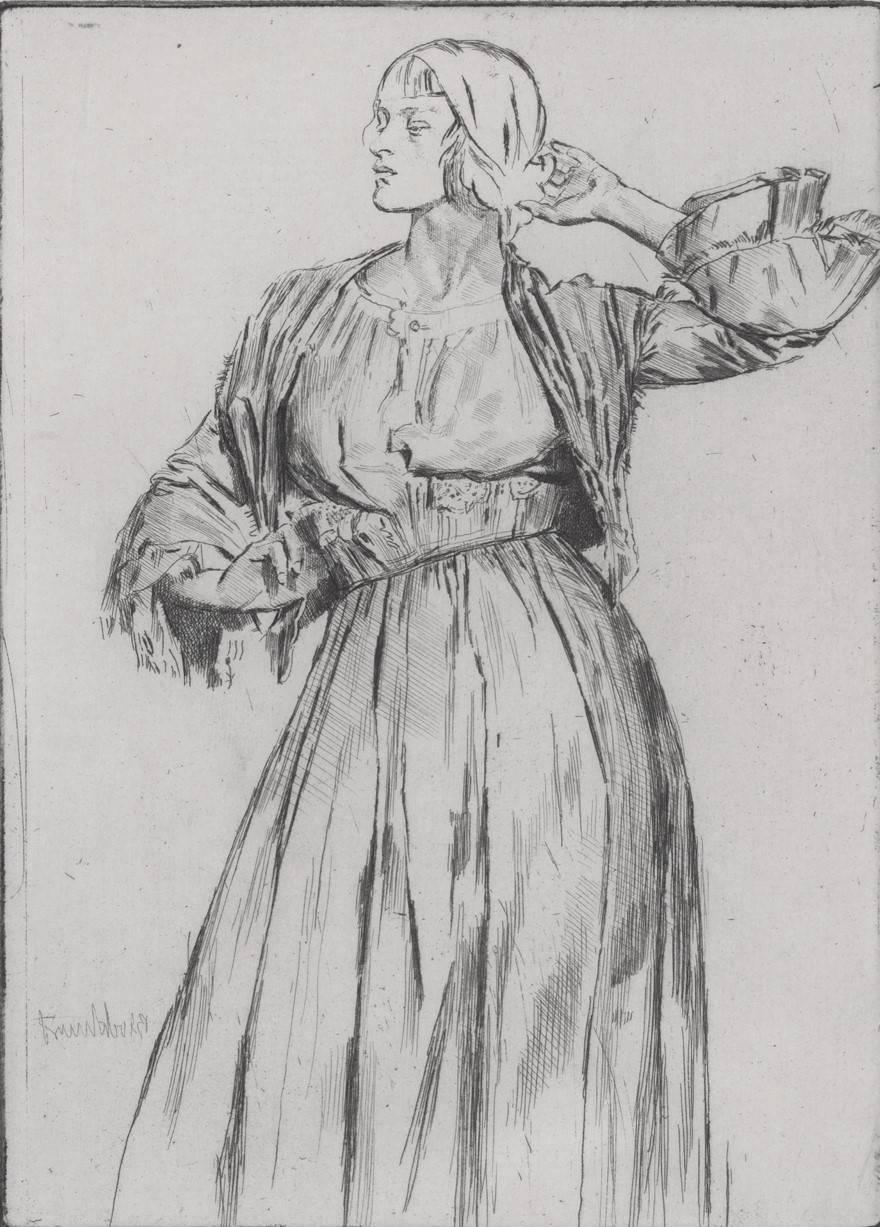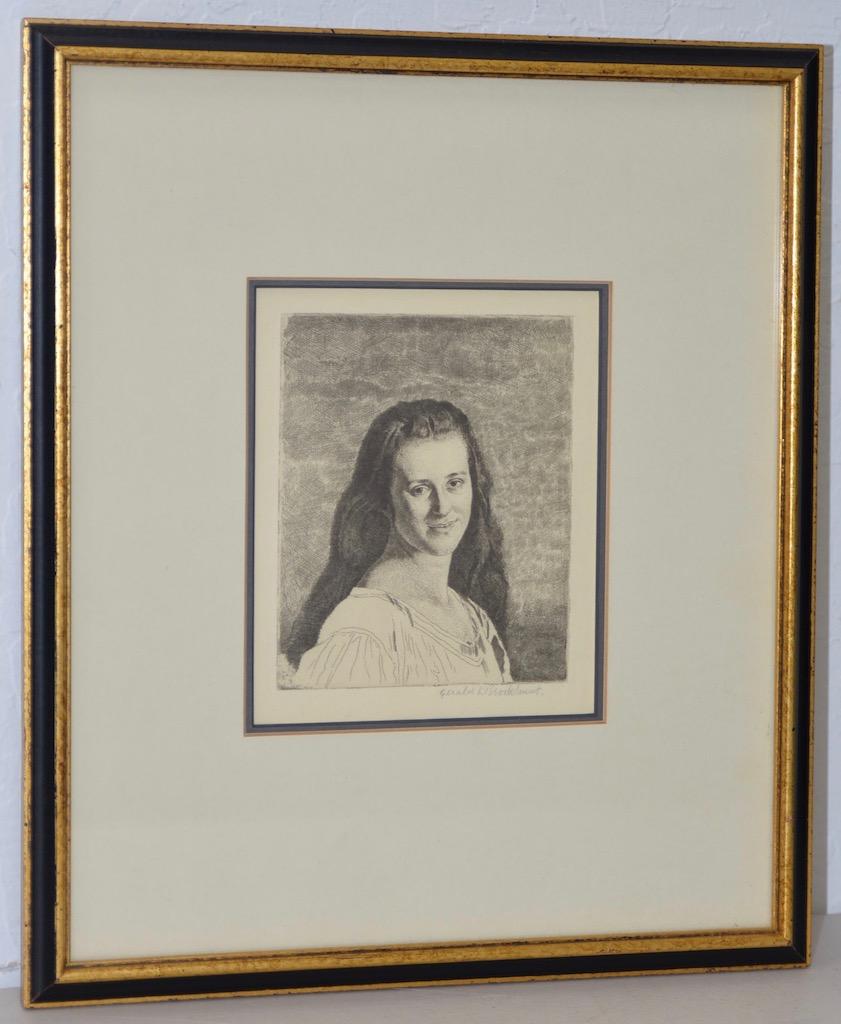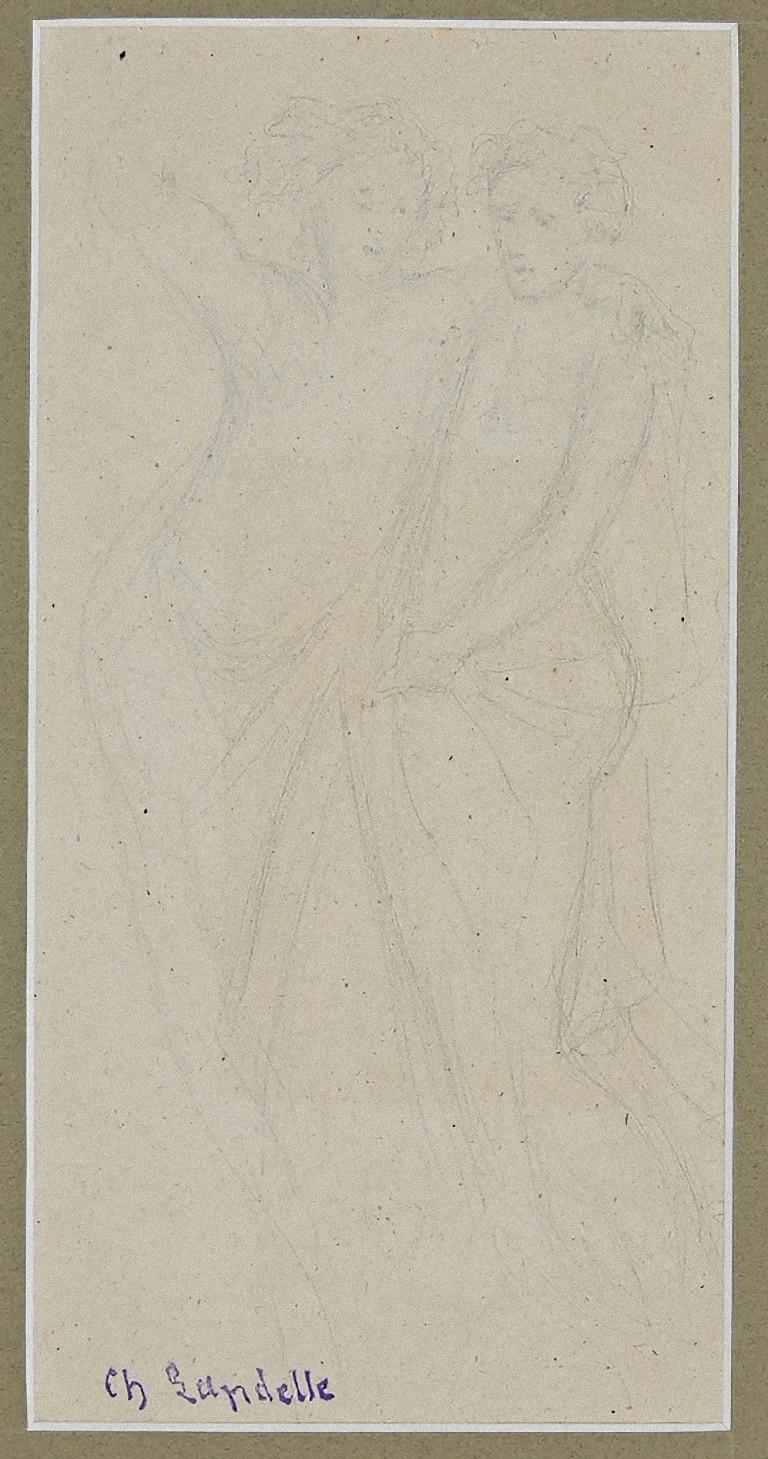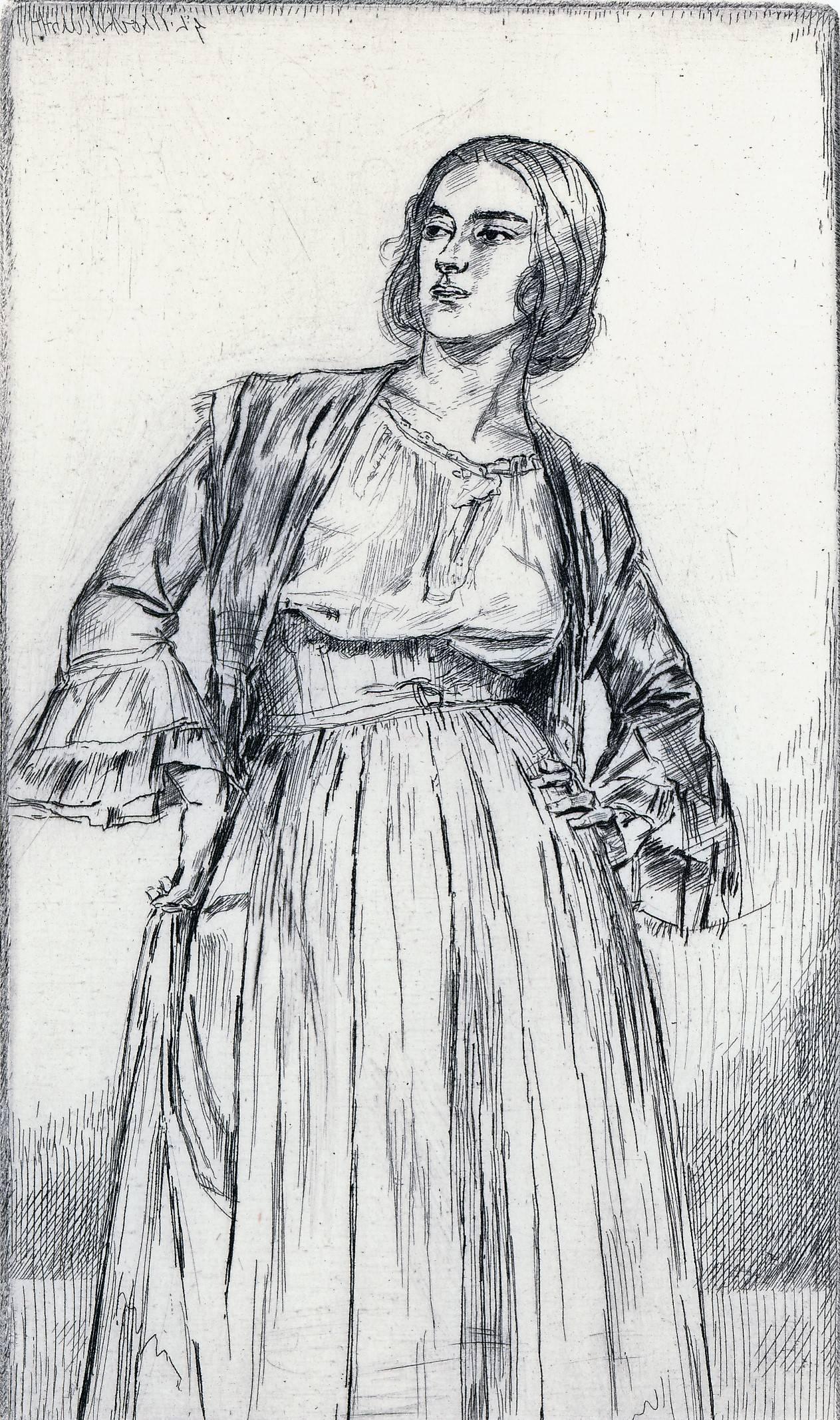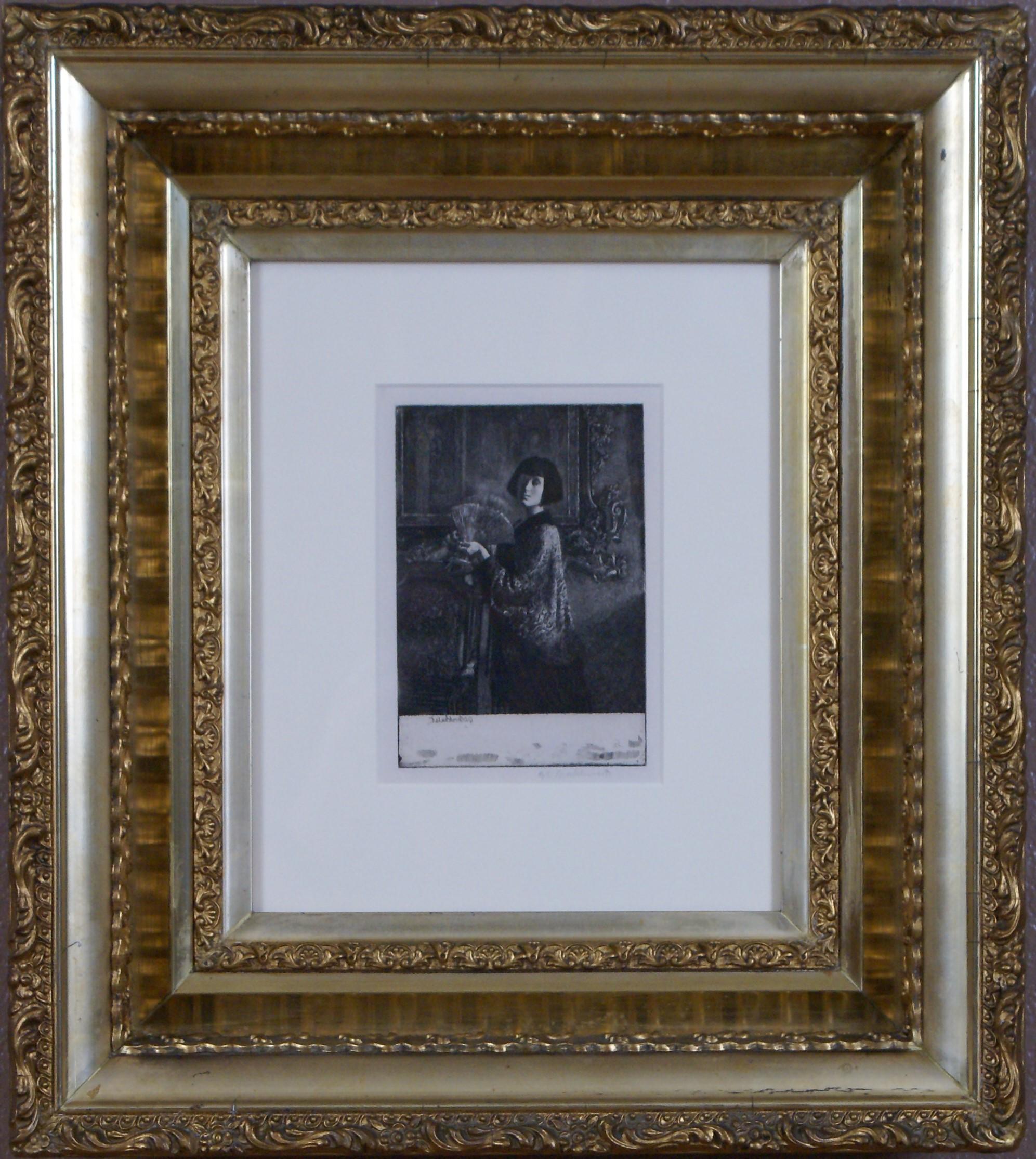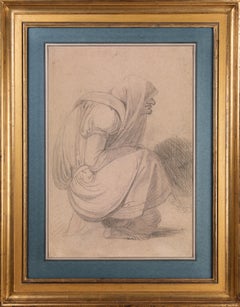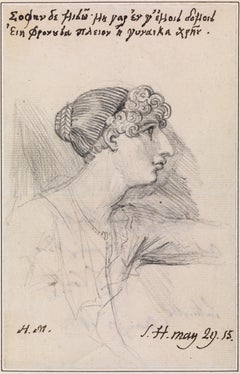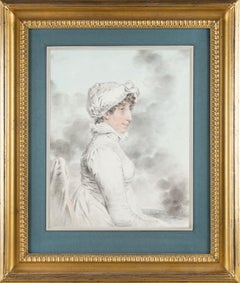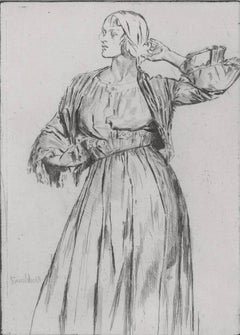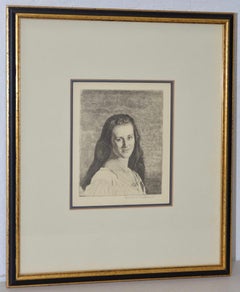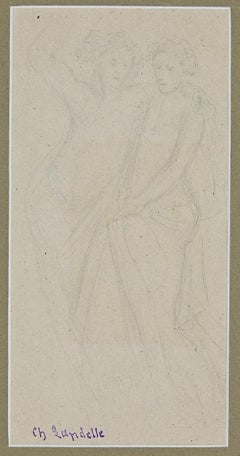Items Similar to 20th century British Drawing - Les Deux Landaises (Evening)
Want more images or videos?
Request additional images or videos from the seller
1 of 8
Gerald Leslie Brockhurst20th century British Drawing - Les Deux Landaises (Evening)circa 1920
circa 1920
$53,813.48
£39,000
€45,840.90
CA$73,190.04
A$82,009.05
CHF 42,688.83
MX$1,003,254.59
NOK 541,855.72
SEK 511,776.25
DKK 342,211.75
Shipping
Retrieving quote...The 1stDibs Promise:
Authenticity Guarantee,
Money-Back Guarantee,
24-Hour Cancellation
About the Item
Pencil on paper
Signed 'G.L. Brockhurst’ (lower right)
Drawn c.1920
Collections:
The Fine Art Society, London, 1981;
Mr & Mrs Alan Fortunoff, acquired from the above;
Private collection to 2019
Literature:
Stephen Wildman (et al), A Dream of Fair Women: An Exhibition of the Work of Gerald Leslie Brockhurst, R.A. (1890-1978): Painter and Etcher, exhibition catalogue, 1986, no. 49.
Exhibition:
London, The Fine Art Society, 1981;
Sheffield, Graves Art Gallery, Birmingham, City Art Gallery and London, National Portrait Gallery, A Dream of Fair Women: An Exhibition of the Work of Gerald Leslie Brockhurst, R.A. (1890-1978): Painter and Etcher, 1986-87 1987, no. 49;
London, The Fine Art Society, Gerard Leslie Brockhurst, 2011, no.12.
This spectacular drawing was made by Gerald Leslie Brockhurst in around 1920, it depicts his wife Anaïs seated whilst her sister, Marguerite Folin, stands dressing her hair; the drawing was turned into an etching by Brockhurst in 1923. Brockhurst variously called the print ‘Les Deux Landaises’, the two girls from Landes, a reference to the area of South-West France which was the native region of Anaïs and her sister and ‘Evening’. The tender and intimate drawing demonstrates Brockhurst’s virtuosic handling of graphite and his self-conscious interest in a long tradition of depicting women at their toilet. Rendered minutely in etching, the print points to Brockhurst’s specific interest in Rembrandt, recalling, as it does, The Great Jewish Bride.
Brockhurst was born in Birmingham where, in 1901, he was registered at the Birmingham School of Art. He won a place at the Royal Academy Schools in 1907. At the Academy, among other awards, he won the gold medal and travelling scholarship which enabled him to visit Paris and Italy where he became enthralled by the art of fifteenth-century Italian painters, specifically the work of Piero della Francesca. Their influence was to be central to the evolution of his own artistic development. On 5 December 1911, in Chelsea, he married his first wife, Anaïs Folin whose distinctive features provided the inspiration for many of his early portraits. During the 1920s Brockhurst established himself first as a printmaker of outstanding virtuosity and second as one of the most original and successful portrait painters of his generation. Brockhurst produced a sequence of eerily unsettling images of the greatest icons of the decade including the Duchess of Windsor, Merle Oberon and J. Paul Getty.
This intensely worked drawing of Anaïs and her sister was made in preparation for an etching published in 1923. Brockhurst’s sheet shows him carefully building up the composition, deliberately densely drawing areas such as Anaïs’s hair and the concentrated expression of her sister, leaving other areas, such as the table and contents of the room only lightly suggested. These decisions are reflected and developed in the finished etching where, for example, the blank table of the drawing is cast into gradated shadow in the finished print. Brockhurst’s feathery touch and minutely layered hatching point to the enduring impact of studying fifteenth-century Italian art, in the present sheet the graphite is handled with the dexterity of metal point. This drawing belonged to the most considerable collectors of Brockhurst’s works in the late twentieth century, Alan and Helene Fortunoff.
- Creator:Gerald Leslie Brockhurst (1890 - 1978, English)
- Creation Year:circa 1920
- Dimensions:Height: 14.25 in (36.2 cm)Width: 11.5 in (29.21 cm)
- Medium:
- Period:
- Condition:
- Gallery Location:London, GB
- Reference Number:1stDibs: LU150728412262
Gerald Leslie Brockhurst
(b Birmingham, 31 Oct. 1890; d Franklin Lakes, NJ, 4 May 1978). British-born painter and etcher who became an American citizen in 1949. Precociously gifted, an excellent draughtsman, and a fine craftsman, Brockhurst won several prizes at the Royal Academy Schools and went on to have a highly successful career as a society portraitist, first in Britain and then in the USA, where he settled in 1939, working in New York and New Jersey. He is best known for his portraits of glamorous women, painted in an eye-catching, dramatically lit, formally posed style similar to that later associated with Annigoni. As an etcher Brockhurst is remembered particularly for Adolescence (1932), a powerful study of a naked girl on the verge of womanhood staring broodingly into a mirror—one of the masterpieces of 20th-century printmaking.
About the Seller
5.0
Recognized Seller
These prestigious sellers are industry leaders and represent the highest echelon for item quality and design.
1stDibs seller since 2021
- ShippingRetrieving quote...Shipping from: London, United Kingdom
- Return Policy
Authenticity Guarantee
In the unlikely event there’s an issue with an item’s authenticity, contact us within 1 year for a full refund. DetailsMoney-Back Guarantee
If your item is not as described, is damaged in transit, or does not arrive, contact us within 7 days for a full refund. Details24-Hour Cancellation
You have a 24-hour grace period in which to reconsider your purchase, with no questions asked.Vetted Professional Sellers
Our world-class sellers must adhere to strict standards for service and quality, maintaining the integrity of our listings.Price-Match Guarantee
If you find that a seller listed the same item for a lower price elsewhere, we’ll match it.Trusted Global Delivery
Our best-in-class carrier network provides specialized shipping options worldwide, including custom delivery.More From This Seller
View AllDrawing of a captive woman
By Henry Fuseli
Located in London, GB
Collections:
Sir Thomas Lawrence, who acquired the contents of Fuseli’s studio;
Susan, Countess of Guilford, née Coutts (1771-1837), acquired from the Lawrence estate;
Susan, Baroness North (1797-1884), daughter of the above;
Mrs A. M. Jaffé, acquired in France, c. 1950 to 2016.
Black chalks, on buff-coloured paper
Stamped verso: ‘Baroness Norths Collection / of Drawings by H Fuseli Esq.’
Framed dimensions: 26.38 x 20.63 inches
This boldly drawn sheet depicting a seated figure was made by Fuseli at an important and highly productive moment in his career. The monumental drawing is closely related to another sheet by Fuseli in the British Museum which Schiff published as subject unknown. Both drawings were made when Fuseli was designing his most important sequence of historical works, including scenes from Shakespeare and Milton, The Nightmare and The Death of Dido which was exhibited at the Royal Academy to great critical acclaim in 1781. The present drawing does not relate directly to any of Fuseli’s finished historical paintings of the period, but evidently the image of a slightly menacing, seated and covered old woman was precisely the sort of motif he was playing with. It is notable that the same figure reappears later in Fuseli’s work as the witch from Ben Jonson’s Witch’s Song which Fuseli produced as both a painting and engraving in 1812.
Fuseli returned to London in 1779 from a highly creative and productive period in Rome and established himself as one of the leading history painters of the period. Fuseli re-established contact with his old mentor Sir Joshua Reynolds, becoming a regular guest at his dinner table and visitor to his studio. The earliest and most striking manifestation of this strategy was Fuseli's Death of Dido, exhibited in 1781 at the Royal Academy. Executed on the same scale as Reynolds's version (Royal Collection), Fuseli's vertically oriented picture was hung directly opposite Reynolds's with its horizontal orientation, inevitably inviting comparison between the two works and garnering Fuseli much publicity and favourable reviews in the newspapers.
The present, previously unpublished sheet, relates closely to a drawing now in the British Museum. That sheet shows the same seated old woman, drawn on a smaller scale and more schematic in design, seated next to an anatomical drawing of a man. The pose of this figure is related to the pose of Dido in his Death of Dido; the foreshortened torso, arrangement of head, oblique view of Dido’s features and arms all suggest that the study can be viewed as an initial thought for the composition. Fuseli may have initially thought of including the figure of the hunched and covered old woman. Drawn on identical paper to the British Museum sheet, our study is an enlarged depiction of the same figure, more elaborately delineated and developed. The presence of a chain to the right of the figure, suggests that the iconography was related in some way to a scene of imprisonment.
Fuseli had first explored the motif of the hooded old woman in an early Roman drawing, 'The Venus Seller'. The idea of a grotesque old woman, hooded and with angular nose and projecting chin seen in profile was most spectacularly used by Fuseli in his sequence of paintings depicting The Three Witches from Macbeth. Fuseli seems to have kept the present sheet and may have returned to it when preparing a painting of The Witch and the Mandrake from Ben Jonson’s Witch’s Song from his Masque of Queens in 1812. Here the same seated figure looks out from under her hood and picks a mandrake by moonlight. Jonson’s drama had been performed at the court of James I in 1609, inspired the subject. To throw the nobility of the queens into relief, the poet added a coven of witches, one of whom declares: ‘I last night lay all alone, On the ground, to hear the mandrake groan; And plucked him up, though he grew full low, And, as I had done, the cock did crow.’ The figure was reversed in the associated etching which was published in 1812. It seems likely that the present drawing remained as part of Fuseli’s working archive of figure studies.
The present drawing was presumably purchased with the bulk of Fuseli’s drawings after the artist’s death by Sir Thomas Lawrence. Lawrence’s large group of Fuseli drawings were then acquired by Susan, Countess of Guildford (1771-1837). Lady Guildford was the eldest daughter of the banker Thomas Coutts (1735-1822), who himself had supported Fuseli’s journey to Rome in the 1770s and had remained one of the artist’s key...
Category
18th Century Old Masters Figurative Drawings and Watercolors
Materials
Chalk
Portrait drawing of Harriot Mellon, Mrs Thomas Coutts
By Henry Fuseli
Located in London, GB
Inscribed by the artist in pen and brown ink, upper margin: 'σοφὴν δὲ μισῶ: μὴ γὰρ ἔν γ' ἐμοῖς δόμοις / εἴη φρονοῦσα πλείον' ἢ γυναῖκα χρή [Euripides, Hippolytus, 11, 640-41: “But a ...
Category
19th Century Old Masters Portrait Drawings and Watercolors
Materials
Pencil
Regency portrait drawing of Arabella Graham-Clarke
By John Downman
Located in London, GB
Collections:
The sitter, and by descent;
Christie's, 19th March 1928, lot 6;
Private collection to 2019
Literature:
G.C. Williamson, John Downman, A.R.A., his Life and Works, Lon...
Category
Early 19th Century Old Masters Portrait Drawings and Watercolors
Materials
Pencil, Watercolor
18th century ink study for the Leveson-Gower Children
By George Romney
Located in London, GB
Collections: J. Goodfriend, USA.
Brown wash and pencil on laid paper
Framed dimensions: 13.25 x 11.75 inches
This powerful drawing was made at the time that Romney was painting the famous group portrait of the Gower Children now in Abbot Hall Art Gallery, Kendal. Romney was a bold and incisive draughtsman who made numerous rich brown ink studies, principally for historical compositions; by contrast, comparatively few studies linked directly to his portraits survive. The existence of a group of studies for the Gower Children underscores its importance to Romney. The sitters were the five youngest of the eight children of Granville, 2nd Earl Gower who, at the time the portrait was commissioned, was President of the Council in Lord North’s government and one of the best-connected and most influential people in England. The present drawing which is a large scale treatment of the composition in its final form perfectly distils Romney’s conceit: the younger children dancing whilst their elder sister, in the guise of a Bacchante plays the tambourine. The bold and dramatic study underlines both the artistic confidence and classical grandeur Romney gained during his trip to Italy between 1773 and 1775.
The commission from Granville, 2nd Earl Gower to paint five of his children came shortly after Romney’s Continental tour. The initial idea, as represented by the present drawing, seems to have been to paint Lady Anne, the figure on the right of the composition playing the tambourine, who was the youngest of Gower’s first four children by his second wife Lady Louisa Egerton and who married the Rev. Edward Vernon Harcourt, later Archbishop of York, with three of her younger half-siblings by Gower’s third wife, Lady Susanna Stewart: at the left Lady Georgina, who became Countess of St Germans following her marriage to the Hon. William Eliot; at the right Lady Charlotte Sophia, later Duchess of Beaufort and in the centre Lady Susanna, later Countess of Harrowby. Romney added a fifth child to the finished portrait, Gower’s son: Lord Granville, later created Viscount Granville and Earl Granville. In Italy Romney had produced a large number of studies of classical antiquities and old master paintings.
The commission from Gower offered Romney the opportunity to explore a complex multi-figural group, putting into practice the kind of ambitious classical quotations that Reynolds was currently exploiting. In 1773 Reynolds had completed the remarkable group portrait of the Montgomery Sisters, now in the Tate Gallery, London, which showed them adorning a herm of the Roman god Hymen; the composition used a garland to link the three figures who were shown in classical costume dancing at the foot of a Roman sculpture. Scholars have long pointed to a similar sources for the two compositions: the works of Nicolas Poussin. Whilst the Montgomery Sisters is based, in part, on a Bacchanal now in the Musée des Beaux-Arts, the Gower Children has always been associated with Poussin’s Dance to the Music of Time, now in the Wallace Collection, London. It seems more likely that Romney was looking to an antique source in the form of the Borghese Dancers, a Roman relief, then in Palazzo Borghese in Rome. Romney would have seen the relief of interlocking, dancing maidens and would also have known Guido Reni’s Aurora...
Category
18th Century Old Masters Portrait Drawings and Watercolors
Materials
Ink, Pencil
Regency portrait drawing of Lady Nugent
By John Downman
Located in London, GB
Collections:
With Ellis Smith, London;
Private collection, to 2015.
Literature:
G.C. Williamson, John Downman A.R.A., his Life and Works,
p. lviii no...
Category
19th Century Old Masters Portrait Drawings and Watercolors
Materials
Pencil, Watercolor
Eighteenth century Old Master drawing - St Jerome
By John Hamilton Mortimer
Located in London, GB
Pen, ink and wash
Framed dimensions: 9 ½ x 11 ¼ inches
Drawn c. 1763
This small, powerful study shows St Jerome contemplating the bible with a cross and sk...
Category
18th Century Old Masters Figurative Drawings and Watercolors
Materials
Ink, Pen
You May Also Like
Study for a Decoration (Marguérite).
By Gerald Leslie Brockhurst
Located in Storrs, CT
Study for a Decoration (Marguérite). 1926. Etching. Fletcher catalog 46 state ii/iii. 6 7/8 x 5 (sheet 11 3/16 x 9 1/16). 5 proofs in this state (total 76 proofs). Illustrated: Salam...
Category
Early 20th Century Modern Portrait Prints
Materials
Etching
Gerald Brockhurst (1890-1978) "Anais" Pencil Signed Etching c.1930
By Gerald Leslie Brockhurst
Located in San Francisco, CA
Gerald Brockhurst (1890-1978) Etching "Anais" c.1930
Very fine etching by listed English / American artist Gerald Brockhurst.
Title "Anais" Pencil signed - From an edition of 55.
...
Category
Early 20th Century Impressionist Portrait Prints
Materials
Etching
Gentle Evening - Pencil drawing - circa 1914
By Georges Conrad
Located in Paris, IDF
Georges CONRAD (1874-1936)
Gentle evening
Original pencil and color pencil drawing
Signed with the stamp of atelier
On paper 26.5 x 20 cm (c. 10,4 x 7.8 in)
Very good condition, pa...
Category
1910s Academic Figurative Drawings and Watercolors
Materials
Carbon Pencil, Color Pencil
$239 Sale Price
42% Off
Two Figures - Original Pencil on Paper by Charles Landelle - Early 20th Century
By Charles Zacharie Landelle
Located in Roma, IT
Two Figures is a pencil drawing on brown paper by Charles Landelle (1812-1908).
The state of preservation is very good. The sheet is mounted on a car...
Category
Early 20th Century Figurative Drawings and Watercolors
Materials
Pencil
Noémie (Marguérite).
By Gerald Leslie Brockhurst
Located in Storrs, CT
Noémie (Marguérite). 1926. Etching. Fletcher catalog 57 state vi 7 1/8 x 4 3/16 (sheet 10 15/16 x 8 7/16). Edition 111 in this state (total 132 impressions). A fine impression print...
Category
Early 20th Century Modern Portrait Prints
Materials
Etching
L'Eventail (Anaïs) also called The Fan.
By Gerald Leslie Brockhurst
Located in Storrs, CT
L'Eventail (Anaïs) also called The Fan. 1921. Etching. Fletcher 22. Final state. 6 3/8 x 4 7/16 (sheet 11 1/2 x 9 1/4). Edition 76. An extremely rich, tonal impression printed on cr...
Category
1920s Modern Portrait Prints
Materials
Etching
$1,750 Sale Price
30% Off
